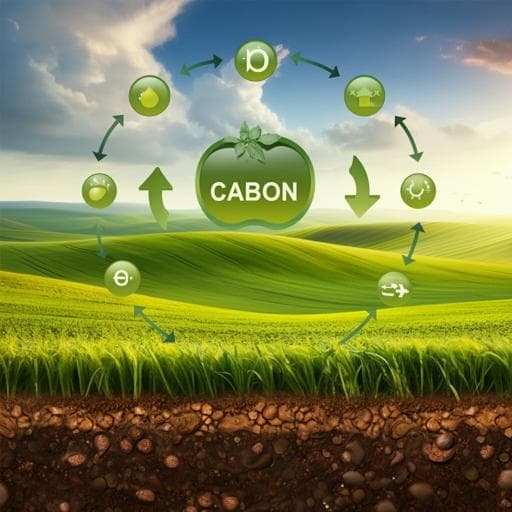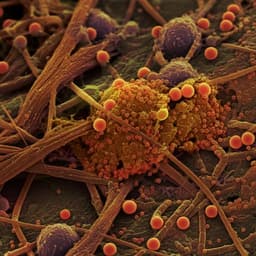
Environmental Studies and Forestry
Maximizing soil organic carbon stocks through optimal ploughing and renewal strategies in (Ley) grassland
T. Hu, S. L. Malone, et al.
This study by Teng Hu, Sparkle L. Malone, Cornelia Rumpel, and Abad Chabbi unveils how ley grasslands in crop rotations play a critical role in enhancing soil organic carbon (SOC) storage, with striking findings that extending ley durations beyond three years does not yield additional benefits. Discover the optimal strategies for ploughing and renewal intervals to maximize SOC stocks under future climate scenarios.
~3 min • Beginner • English
Introduction
Arable cropping in temperate regions has led to substantial declines (30–60%) in soil organic carbon (SOC) due to frequent soil disturbance (e.g., ploughing) and limited biomass carbon inputs. Incorporating ley grasslands into rotations is proposed to mitigate SOC depletion by enhancing below-ground carbon inputs and reducing disturbance. Short-term studies suggest even a single ley phase can help maintain SOC, likely due to efficient nutrient use, high below-ground allocation of grasses, and absence of ploughing during the ley phase. To prevent SOC losses, SOC gains during the ley phase must compensate for losses during cropping, making ley duration a key management lever. Because long-term experiments with varying ley durations are scarce and climate change introduces uncertainty, modeling is needed to identify optimal durations. This study uses the DailyDayCent model, informed by a long-term experiment in western France, to (1) evaluate SOC dynamics in cropping and grassland systems under current and future climates (RCP4.5, RCP8.5, with/without CO2 enhancement), and (2) assess how ley duration and renewal frequency influence SOC. The hypothesis was that longer ley duration would increase SOC via greater below-ground inputs and fewer ploughing disturbances.
Literature Review
Prior work shows arable management often reduces SOC stocks, with reported declines of 30–60% in temperate systems under continuous cropping and frequent tillage. Introducing ley grasslands into rotations has been associated with improved sustainability and SOC storage, as grasses allocate substantial biomass below-ground, which tends to be more recalcitrant and stabilized than above-ground residues. Absence of ploughing during ley phases reduces disturbance-related SOC losses. Evidence indicates even a single ley-cropping cycle can maintain SOC stocks. Conversely, ploughing generally accelerates decomposition in arable systems, but occasional inversion tillage for pasture renewal may enhance SOC over time by burying carbon deeper and incorporating residues. The balance between carbon inputs (biomass) and outputs (heterotrophic respiration) under different management and climates is central to SOC outcomes, motivating model-based assessments where long-term field data are limited.
Methodology
Study site and experiment: Long-term field experiment at the Lusignan National long-term Observatory (Poitou-Charentes, France; continental climate ~800 mm precipitation, 12 °C mean temperature). Soils: upper loamy Cambisol, lower clayey rubefied horizons (Paleo-Ferralsol). Treatments included continuous cropland (CC: maize, winter wheat, winter barley rotation), permanent grassland (PG: mix of Lolium perenne, Festuca arundinacea, Dactylis glomerata), and rotations with ley grasslands (e.g., 6-year grassland followed by 3-year cropland, G6C3). Grasslands were mowed and biomass removed 3–4 times per year; crop residues: maize straw retained. N application followed site management (Supplementary Table 1). Ploughing depth was 25–30 cm during renewal.
Data collection: SOC measured at 0–90 cm in 2005, 2008, 2011, 2014. Bulk densities measured at start; 0–30 cm reassessed without significant change. On-site meteorology recorded (PAR, net radiation, precipitation, air temperature/humidity, pressure) and soil temperature and volumetric water content at multiple depths.
Eddy covariance: Net ecosystem exchange (NEE) measured continuously (2011–2014) at PG and G6C3 with open-path IRGA (LI-7500) and 3-D sonic anemometer (R3-50) at 20 Hz, processed to 30-min fluxes with standard QA/QC and gap-filling protocols.
Model: DailyDayCent used to simulate plant–soil–atmosphere carbon dynamics. Parameterization used site-specific soil and management parameters (texture, field capacity, wilting point, hydraulic conductivity, SOC, pH), crop rotations, fertilization, cultivation, and harvest operations. Historical land-use simulated for spin-up (temperate forest to 1750; grass grazing 1750–1845; ley-arable rotation 1845–2004). Daily climate (2006–2015) cycled for spin-up (~2000 years) and baseline simulations. Ploughing events in the model transfer above- and below-ground biomass to topsoil and modify decomposition rates across litter and SOM pools (active, slow, passive). Parameter estimation (PEST) used NEE and harvested biomass C to calibrate crop and site parameters; model performance evaluated with RMSE, model efficiency, and R2 (satisfactory MF ≥ 0.40; efficient MF > 0.7).
Climate scenarios and treatments: Future simulations (2016–2100) used regional projections from IPSL and CNRM for RCP4.5 and RCP8.5, each with and without CO2 enhancement (to ~538 ppm for RCP4.5; ~935 ppm for RCP8.5). Eight climate scenarios total. Simulated treatments: continuous grasslands with varying renewal frequency G1 (annual), G2 (every 2 y), G3 (every 3 y), G4 (every 4 y), G6 (every 6 y), PG (no tillage); and crop rotations CC (continuous crops), C3G3 (3-year grass, 3-year crops), G6C3 (6-year grass, 3-year crops).
Carbon balance calculations: NECB = NPP − Rh − Charvest (exogenous inputs, dissolved/leached C, fire, volatile, CH4, erosion considered negligible). Soil C balance (SCB) and residue C balance (RCB) computed with RCB = NECB − SCB. SOC excludes undecomposed plant residues by definition. Model validation: Daily NEE R2 0.46 (PG) and 0.58 (C3G3); monthly NEE R2 > 0.7 for both; SOC simulation vs observations R2 = 0.70.
Key Findings
- Ley grasslands in rotations increased SOC storage by ~10 Mg C ha−1 over 96 years compared with continuous cropping (CC), under all climate scenarios.
- Extending ley duration from 3 to 6 years did not further enhance SOC storage.
- Compared to non-renewed permanent grassland (PG), grasslands renewed every 3 years (G3) increased SOC storage by ~0.3 Mg C ha−1 yr−1.
- Biomass C inputs (2005–2100):
• Continuous grasslands: 403.5–568.8 Mg C ha−1; maximum for G3: 568.8 ± 35.8 Mg C ha−1.
• CC (no ley): 299.6 ± 14.7 Mg C ha−1.
• C3G3 (3-yr ley): 437.7 ± 22.8 Mg C ha−1.
• G6C3 (6-yr ley): 481.4 ± 25.6 Mg C ha−1.
- Heterotrophic respiration Rh (2005–2100):
• Continuous grasslands: 428.0–570.7 Mg C ha−1; highest for G3.
• CC: 336.2 ± 13.1 Mg C ha−1; C3G3: 455.6 ± 20.3 Mg C ha−1; G6C3: 495.4 ± 23.4 Mg C ha−1.
- NECB: All treatments lost C without CO2 enhancement; with CO2 fertilization, some continuous grasslands (G2–G4) showed net gains. Relative to CC, adding leys reduced cropping system C loss by 18.7 ± 4.9 Mg C ha−1 (3-yr ley) and 22.6 ± 4.9 Mg C ha−1 (6-yr ley).
- SOC change (2005–2100):
• G3 lost 8.5 ± 4.9 Mg C ha−1, but maintained higher SOC than other renewal frequencies.
• C3G3 and G6C3 declined by 21.7 ± 4.2 and 22.6 ± 3.7 Mg C ha−1, respectively, yet each maintained ~10 Mg C ha−1 more SOC than CC under all scenarios.
- Longer ley durations increased undecomposed residue C pools but did not translate into higher SOC.
- RCP8.5 had higher temperatures than RCP4.5; SOC declined more under RCP8.5; CO2 enhancement increased biomass inputs, residues, SOC, and Rh across treatments.
Discussion
The study addressed how ley duration and renewal frequency influence SOC under current and future climates by balancing carbon inputs from biomass against heterotrophic respiration. Contrary to the initial hypothesis that longer leys would always enhance SOC, the optimal SOC outcomes occurred with a 3-year renewal frequency (G3) in continuous grasslands, where ploughing and renewal generated substantial carbon inputs from rapidly growing roots and incorporated residues that outweighed increased Rh. Very frequent renewal (e.g., annual) or very infrequent renewal (e.g., 6-year) resulted in carbon inputs that were too low relative to Rh. In crop rotations, integrating ley phases reduced SOC losses compared to continuous cropping, but extending leys from 3 to 6 years had little effect on SOC storage, instead increasing undecomposed residue carbon. Climate effects modulated the balance: higher temperatures in RCP8.5 increased Rh more than inputs, leading to larger SOC declines; CO2 fertilization mitigated losses by boosting NPP and inputs. Overall, optimal ploughing and renewal intervals can enhance SOC sequestration by tuning the timing of biomass inputs relative to decomposition, with the 3-year renewal emerging as a robust strategy at the Lusignan site.
Conclusion
Model–experiment integration shows that introducing ley grasslands into crop rotations increases SOC relative to continuous cropping, and that optimizing ploughing and renewal intervals—specifically, renewing every three years—maximizes SOC storage in continuous grassland systems under both current and future climates at the studied site. Extending ley phases beyond three years does not further increase SOC and primarily accumulates carbon in undecomposed residues. These findings highlight the importance of balancing biomass carbon inputs with heterotrophic respiration through targeted renewal schedules. Future research should test and calibrate optimal ley durations across diverse pedoclimatic contexts, soil types, and management systems to develop region-specific SOC mitigation strategies and assess long-term trade-offs, including residue dynamics and greenhouse gas fluxes.
Limitations
- Site-specific study focused on a mowed grassland system in western France; results may not generalize to different climates, soils, or management without local calibration.
- Single model (DailyDayCent) used; while validated against NEE and SOC, structural model uncertainty remains.
- Climate scenarios limited to RCP4.5 and RCP8.5 from two data sources; other scenarios and extremes not explored.
- NECB simplifications excluded minor carbon loss pathways (dissolved, fire, volatile, CH4, erosion) as negligible; small biases may persist.
- Assumptions of stable bulk densities at depth and specific residue handling may affect absolute SOC estimates.
- Management specifics (e.g., mowing removal, fertilization) may influence transferability to grazed systems or different crop types.
Related Publications
Explore these studies to deepen your understanding of the subject.







